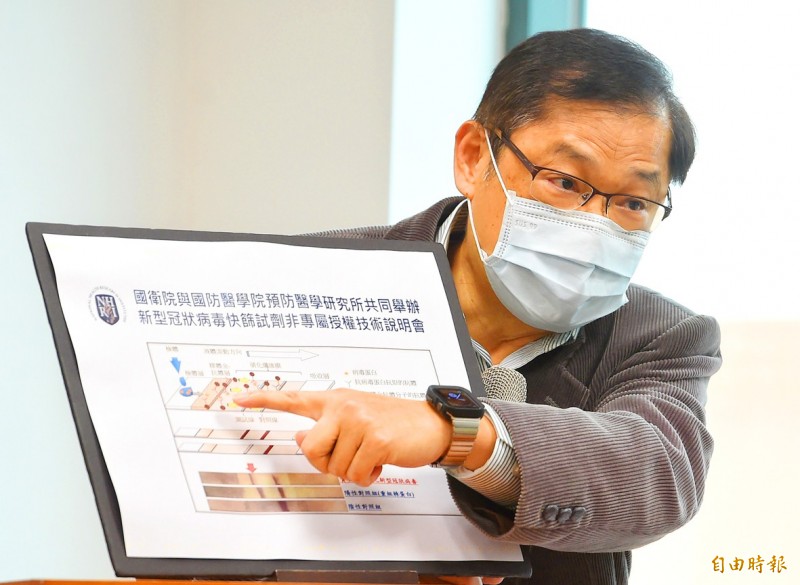《TAIPEI TIMES》Institutes unveil prototype rapid test kit

National Institute of Infectious Disease and Vaccinology Director Liao Ching-len explains the functions of a prototype COVID-19 rapid diagnostic tool in Taipei yesterday. Photo: Liu Hsin-de, Taipei Times
By Lee I-chia / Staff reporter
The National Health Research Institute (NHRI) and the National Defense Medical Center yesterday announced a prototype COVID-19 rapid diagnostic kit that can provide results in about 15 minutes.
The NHRI and the center’s Institute of Preventive Medicine used SARS-CoV antibodies produced during the SARS outbreak in 2003 and picked out one that can identify SARS-CoV-2, which causes COVID-19, to develop the rapid test kit.
After spending a month developing the test kit, the institutes yesterday in Taipei presented the prototype to pharmaceutical companies in the hope of achieving technology transfers and starting mass production.
The test works by placing a specimen taken from the mouth or nose onto a test strip, which siphons the specimen toward the antibodies on the strip, NHRI National Institute of Infectious Disease and Vaccinology Director Liao Ching-len (廖經綸) said.
As researchers have identified the coronavirus’ spike protein, if the specimen contains SARS-CoV-2, the spike protein would be caught by the antibody and two lines would appear on the test strip, indicating a positive result, he said.
The results are shown in a similar fashion to a pregnancy test — one line means negative and two lines means positive — Liao said.
The prototype has been proven to avoid cross-reaction with other viruses, including human coronaviruses OC43, 229E and NL63; adenoviruses; respiratory syncytial virus; type A influenza viruses H1N1, H5N1 and H7N9; and enterovirus 71, he said.
The prototype is not meant to replace the real-time reverse transcription polymerase chain reaction test, which is currently being used for diagnosis, he said, adding that they hope the rapid test will be used as a complementary measure to allow hospitals to screen patients rapidly and sort them, Liao said.
They also hope experienced pharmaceutical companies can join them in refining the prototype, and manufacture and release the final product for front line disease prevention, he added.
NHRI President Liang Kung-yee (梁賡義) said that the Food and Drug Administration has also launched a scheme, which grants permission for clinical trials and mass production at the same time, to shorten the duration required for a product to hit the market.
If the procedures go smoothly, the test kit could be out in three months, Liang said.
Other countries have also expressed an interest in technology transfers, but the NHRI wants to give priority to Taiwanese companies, he added.
新聞來源:TAIPEI TIMES














